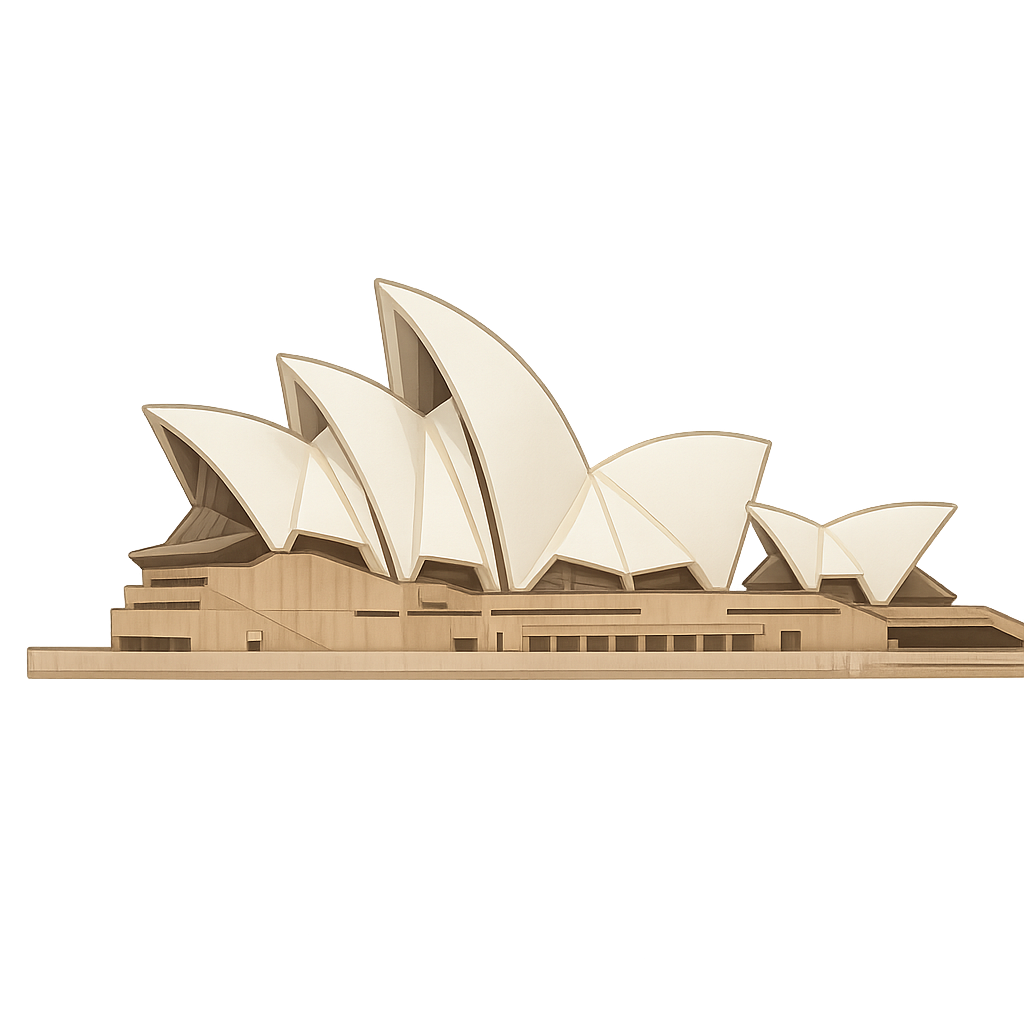The House of Sails
I gaze out over the sparkling blue water of a magnificent harbour, my white skin gleaming in the Australian sun. To my side, a grand old coat hanger of steel, the Sydney Harbour Bridge, keeps me company. My unique shape has been compared to many things—the billowing sails of a ship ready for adventure, or a cluster of giant, beautiful seashells washed ashore. From my steps, I hear the chug of ferries carrying people across the water, the distant hum of the city, and the cry of seagulls dancing on the breeze. I am a place built not of simple bricks and beams, but of imagination and sound. I was designed to hold the world’s most beautiful music, its most thrilling stories, and its most breathtaking dances. I am a house for dreams. I am the Sydney Opera House.
My story began long before my first tile was laid, back in the 1950s. The world was changing after a long war, and the people of Sydney felt a new wave of optimism. They dreamed of a city that was a major player on the world stage, a place known not just for its beaches and bridges, but for its culture and art. They needed a home for their orchestras and opera companies, a venue that was as spectacular as the performances it would host. So, in 1955, the government announced an international competition, inviting architects from all over the globe to submit their designs. Hundreds of ideas poured in, but one stood out. It was a sketch by a Danish architect named Jørn Utzon. His drawings were unlike anything anyone had ever seen—graceful, sculptural, and incredibly ambitious. His design was so radical that it was initially discarded by the judges. But thankfully, one judge arrived late, pulled it from the rejection pile, and declared it a masterpiece. In 1957, Jørn Utzon was announced as the winner, and my journey from a dream on paper to a reality of concrete and steel began.
Building me was one of the greatest architectural puzzles of the 20th century. Construction began on March 2, 1959, and almost immediately, the builders faced a monumental challenge: my roofs. Those soaring, curving shells were beautiful on paper, but no one knew how to actually build them so they wouldn't collapse. For years, engineers and architects wrestled with the problem. The breakthrough came from Jørn Utzon himself, who, in a moment of inspiration, realized the curves of my shells could all be derived from the surface of a single, perfect sphere. This elegant solution meant the curved roof sections could be cast from a reusable mold, making the impossible, possible. The brilliant engineer Ove Arup and his team used early computers—which were rare and enormous back then—to perform the millions of calculations needed to ensure my strength and stability. The journey was not always smooth. In 1966, after disagreements over the cost and interior designs, Jørn Utzon sadly left the project and his home country of Denmark, never to see me completed. It was a heartbreaking moment, but a team of talented Australian architects stepped in to finish the work, determined to honor his incredible vision. Finally, I was covered in a skin of over one million special, self-cleaning tiles, which shimmer in the sunlight and give me my iconic glow.
After fourteen years of challenges, innovations, and triumphs, my big day finally arrived: October 20, 1973. A huge crowd gathered around the harbour, and Queen Elizabeth II officially declared me open. For the very first time, my halls were not filled with the sounds of construction, but with the soaring notes of an orchestra playing Beethoven's Ninth Symphony. The sound was magnificent, and I knew I had found my purpose. I am not just one building, but a collection of venues hidden beneath my shells. In my grand Concert Hall, symphony orchestras fill the air with powerful music. In the Joan Sutherland Theatre, singers perform breathtaking operas and dancers leap across the stage in beautiful ballets. In my smaller theaters, actors tell new stories and musicians play everything from rock to jazz. I quickly became the vibrant heart of Sydney’s cultural life, a gathering place where people from all walks of life could come together to share in the wonder of human creativity and performance. I was alive, and my voice was finally ringing out across the harbour.
Today, I am more than just a performing arts center. I am a symbol of Australia, recognized all over the world. In 2007, I was declared a UNESCO World Heritage site, placing me alongside the Pyramids of Egypt and the Great Wall of China as a treasure belonging to all of humanity. I stand as a testament to the power of a bold idea and the incredible things people can achieve when they combine artistry, science, and sheer determination. My story teaches that the most beautiful things are often the most difficult to create, but they are worth the struggle. I continue to be a beacon for the future, inviting everyone to dream big and to fill my halls with new stories, new songs, and new ideas for generations to come.
Reading Comprehension Questions
Click to see answer
